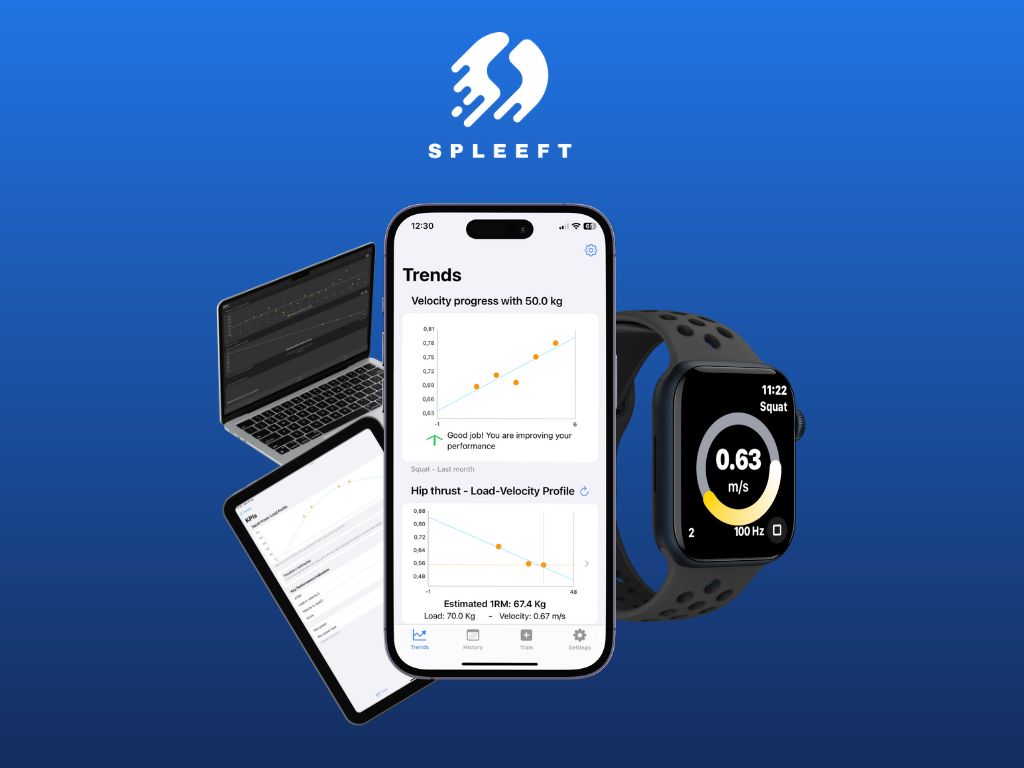Strength training has always been a cornerstone of physical fitness, with methods evolving over the decades to better meet the needs of athletes and fitness enthusiasts alike. One of the more advanced techniques that has gained popularity is rest pause training, a method that effectively pushes the boundaries of traditional set-and-rep schemes. By strategically incorporating short rest periods within a single set, rest pause training enables lifters to maximize their time under tension, leading to greater muscle hypertrophy, strength, and overall performance.
In this comprehensive guide, we’ll explore the intricacies of rest-pause training, delve into its benefits, and show you how to incorporate it into your routine. We’ll also discuss how the Spleeft app can optimize your rest pause workouts by utilizing velocity based training (VBT) metrics to tailor your approach to your specific goals.
DOWNLOAD SPLEEFT APP NOW FOR PHONE, MAC AND WATCH!
Rest Pause Training with Spleeft
What is Rest Pause Training?

Rest-pause training is an advanced strength training technique that involves performing a set of repetitions to near failure, taking a brief rest, and then continuing the set with additional repetitions. This cycle of work and rest is repeated several times within a single set, allowing you to push beyond your usual limits and stimulate greater muscle growth and strength.
The Mechanics
- Initial Set: Start by performing as many repetitions as possible (AMRAP) with a given weight until you approach failure.
- Short Rest: Take a brief rest of around 10 to 20 seconds to recover just enough to continue.
- Subsequent Reps: After resting, perform additional repetitions. Continue this pattern until you can no longer maintain proper form or until you’ve reached a predetermined rep goal.
- Repeat: This entire cycle can be repeated for multiple sets, depending on your workout plan.
The Benefits of Rest Pause Training
Rest-pause training offers several advantages that can significantly enhance your strength and muscle-building efforts:
- Enhanced Muscle Hypertrophy: By extending the time under tension within a set, rest-pause training promotes muscle fiber recruitment and metabolic stress, both of which are key factors in hypertrophy.
- Increased Strength: The brief rest periods allow you to handle heavier weights for more total repetitions, leading to greater strength gains over time.
- Time Efficiency: Rest pause training is a time-efficient method because it condenses more work into a shorter time frame compared to traditional straight sets.
- Improved Mental Toughness: The nature of rest-pause training forces you to push through fatigue, building mental resilience and the ability to handle high levels of exertion.
Implementing Rest-Pause Training

To effectively incorporate rest-pause training into your workout routine, it’s important to consider the exercises, loads, and rep schemes that best suit your goals.
Example Workout
Exercise Selection
Rest-pause training works best with compound movements that engage multiple muscle groups and allow for significant loading. Ideal exercises include:
- Squats: Great for lower body hypertrophy and strength.
- Bench Press: Effective for building upper body strength and muscle mass.
- Deadlifts: Excellent for overall strength and posterior chain development.
- Overhead Press: Targets the shoulders and upper chest.
- Pull-Ups/Chin-Ups: Focuses on back and biceps, particularly effective for upper body hypertrophy.
Load Selection
Choose a weight that is around 80% of your one-rep max (1RM) for strength-focused rest-pause training. For hypertrophy, a slightly lighter load, around 70-75% of your 1RM, can be more effective.
Repetitions and Sets
Start with a rep range of 8-10 reps for your initial set. After the first mini-set, rest for 15-20 seconds, then aim for 4-6 additional reps. Continue this process until you accumulate a total of 20-25 reps per set.
Rest Intervals
Rest intervals are crucial in rest-pause training. For hypertrophy, shorter rest intervals (10-15 seconds) maximize metabolic stress. For strength, slightly longer intervals (15-30 seconds) help maintain lifting intensity.
Progression
As you adapt to rest-pause training, gradually increase the weight or the total number of reps per set. Ensure that progression is slow and controlled to prevent overtraining and injury.
Optimizing Rest Pause Training with Spleeft

Rest-pause training is effective on its own, but when combined with the Spleeft app’s advanced features, it becomes a truly powerful tool for optimizing your performance and results.
Velocity Based Training and Its Benefits
Velocity-Based Training (VBT) is a method that uses the speed of your lifts as a key metric to guide your training decisions. Spleeft’s real-time velocity tracking provides valuable insights into your lifting performance, allowing you to adjust your training on the fly for optimal results.
- Real-Time Feedback: Spleeft tracks your barbell velocity during each rep, offering immediate feedback on your performance. This is particularly useful during rest-pause sets, where maintaining intensity is crucial.
- Objective Measurement: By tracking the speed of your lifts, you can objectively measure your fatigue levels and ensure that you’re training with the appropriate intensity for your goals.
Monitoring Fatigue and Performance
One of the challenges of rest-pause training is managing fatigue while ensuring that each mini-set is performed with maximum effort. Spleeft’s velocity loss percentage feature is invaluable in this regard.
- Tracking Fatigue: Spleeft allows you to monitor the loss of velocity between your first and last reps in a set. A decrease in velocity indicates rising fatigue, which can guide your decision to end the set or take a longer rest.
- Performance Optimization: For optimal performance, it’s recommended to set a velocity loss threshold. For example, a 20% loss in velocity is ideal for strength-focused training, ensuring that you maintain high intensity throughout the set. For hypertrophy, a higher threshold, around 40% or more, is beneficial as it pushes the muscles closer to failure, maximizing growth.
Customizing Rest Intervals
Spleeft enables you to customize rest intervals based on your velocity metrics. If your goal is to maximize strength, you can adjust your rest periods to ensure that you maintain a consistent velocity across reps. For hypertrophy, shorter rests combined with a higher velocity loss percentage can create the metabolic stress needed for muscle growth.
Setting Velocity Loss Percentages
Spleeft app’s ability to track and set velocity loss percentages is a game-changer for those looking to fine-tune their rest-pause training:
- 20% Velocity Loss: Ideal for performance-focused training. By setting your threshold to 20%, you ensure that each rep is performed with maximum intent, maintaining high levels of power and strength.
- 40% Velocity Loss: Perfect for hypertrophy. A 40% loss in velocity indicates that you are pushing your muscles to their limits, creating the mechanical tension and metabolic stress needed for muscle growth.
By adjusting these thresholds based on your training goals, you can ensure that every set is optimized for the results you’re aiming for.
The Science Behind Rest-Pause and Velocity-Based Training
Rest-pause training and VBT are grounded in solid scientific principles. Research has shown that mechanical tension, muscle damage, and metabolic stress are the primary drivers of muscle hypertrophy. Rest-pause training amplifies these factors by extending time under tension and increasing the total workload within a set.
VBT, on the other hand, ensures that each set is performed with the highest possible quality by providing real-time feedback on your lifting speed. This combination of techniques allows you to train with precision, ensuring that every rep counts and that you’re continuously progressing toward your goals.
How Spleeft Enhances Your Strength Training
Spleeft isn’t just a training app; it’s a comprehensive tool designed to enhance every aspect of your workout routine:
- Real-Time Feedback: Instantly see how fast you’re moving the barbell and make adjustments to your technique or load in real-time.
- Customizable Metrics: Focus on the metrics that matter most to you, whether it’s velocity loss, peak velocity, or time under tension.
- Load-Velocity Profiles: Use Spleeft’s load-velocity profiles to estimate your 1RM, allowing you to adjust your training loads dynamically for maximum efficiency.
- Performance Tracking: Over time, Spleeft helps you track your progress, showing trends in your performance and highlighting areas for improvement.
Practical Tips for Rest-Pause Training

- Start Conservatively: If you’re new to rest-pause training, begin with lighter weights and shorter rest intervals. Gradually increase the load and rest periods as you become more comfortable with the technique.
- Focus on Form: Proper form is essential, especially when training close to failure. Ensure that each rep is performed with perfect technique to avoid injury.
- Monitor Your Progress: Use Spleeft to track your performance over time. Regularly review your velocity data to ensure that you’re making steady progress and adjust your training accordingly.
- Prioritize Recovery: Rest-pause training is intense, so make sure to prioritize recovery. Adequate sleep, nutrition, and hydration are crucial for muscle repair and growth.
Rest-Pause Training for Different Goals
Rest-pause training is highly adaptable and can be tailored to meet a variety of fitness goals:
Hypertrophy
For hypertrophy, the goal is to maximize metabolic stress and time under tension. This can be achieved by using moderate weights (70-75% of 1RM), shorter rest intervals (10-15 seconds), and a higher velocity loss threshold (around 40%). This approach ensures that your muscles are pushed to their limits, stimulating growth.
Strength
If strength is your primary goal, focus on using heavier weights (80-85% of 1RM) and slightly longer rest intervals (15-30 seconds). A lower velocity loss threshold (20%) will help you maintain power and intensity throughout your sets, ensuring that you’re building strength without excessive fatigue.
Endurance
For endurance, use lighter weights (60-70% of 1RM) with very short rest intervals (5-10 seconds). This approach builds muscular endurance by keeping your muscles under tension for extended periods, improving your ability to sustain high-intensity efforts over time.
Conclusion
Rest-pause training is a versatile and powerful technique that can help you break through plateaus and achieve new levels of strength, hypertrophy, and endurance. When combined with the advanced features of the Spleeft app, your training becomes even more effective, allowing you to optimize every aspect of your workout routine.
By leveraging velocity-based training metrics and real-time feedback, Spleeft empowers you to train smarter, not just harder. Whether you’re aiming to build muscle, increase strength, or improve endurance, rest-pause training with Spleeft is the perfect combination to take your training to the next level.
Don’t let your progress stall—start incorporating rest-pause training into your routine today and experience the benefits of this advanced training technique. With Spleeft by your side, you’ll have all the tools you need to achieve your fitness goals and push beyond your limits.





